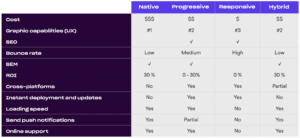
Native, responsive, progressive, or hybrid applications: Which technology should you choose?
Relied on every day by millions of people, mobile apps have become much more widely used than websites.
According to Comscore, mobile applications account for nearly 80% of all online traffic. Undoubtedly, today’s customers are more likely to open an app on their phones than to enter a URL into a browser. Needless to say, investing in a mobile app is imperative to your business’s success!
Choosing your mobile application
To find the tool that’s right for you, it’s necessary to get acquainted with all four types of mobile applications and understand how each one works. To analyse your needs and determine precisely what to look for, ask yourself:
- What are the goals and limitations of your mobile application development project?
- Who will be using your app?
- Is it a paid application?
- What are your application development priorities?
- What features do you want to put forward?
- Does your application need to available offline (either partially or fully)?
Keep reading to learn more about the different types of mobile apps so you can make an informed choice!
Native applications
A native application is developed with unique source codes for different operating systems—with iOS, the programming languages used are Swift or Objective-C whereas native apps for Android employ Java or Kotlin. Once downloaded, these apps can be used without an internet connection.
Why is opting for a native mobile app worthwhile?
- Maximises the graphics performance of your application
- Takes advantage of the best practices and tools specific to each operating system (and, in turn, offers a winning user experience)
- Can employ the different features of different devices (camera, GPS, accelerometer, etc.)
However, despite their ergonomic advantages, native applications represent a greater programming effort—the code must be developed for Apple and Android operating systems separately. And don’t forget about the 30% “store tax” that Google Play and Apple Store pocket from every purchase! Moreover, Apple must approve every one of your updates, which sometimes leads to delays.
In short, a native application is a powerful tool that respects the native features and design of any device and platform. It is thus the perfect choice for targeting loyal Apple and Android users.
Examples of native applications: La Presse, SAQ, Google Maps, Facebook, LinkedIn
Web applications (responsive and progressive)
Many people use responsive apps every day without realising that they’re actually browsing websites. As the name suggests, a responsive web application is simply the “mobile” version of a website. A responsive app is hosted on a server and can be programmed with :
- HTML
- CSS
· JavaScript
· Typescript
The obvious main advantage of these applications is that they are only developed once and work with all systems. Of course, unlike native applications, responsive apps require the internet. Nevertheless, there are several good reasons to opt for a responsive application:
- Economical
- Instant deployment
- Instant updates
Driving this type of application’s popularity are businesses with more limited budgets. However, if you are looking to develop a more professional cross-platform mobile application, a superior option is available.
Offering greater possibilities, a progressive application, also called a PWA (Progressive Web App), is a more evolved version of a responsive app. In fact, responsive applications are often gradually transformed into progressive versions. Like a responsive app, a PWA is, in fact, a website, but also adds an icon to your mobile device. Thus, most people cannot distinguish between progressive applications and native applications. And just like native applications, these interfaces have an offline mode. Additionally, like responsive and hybrid applications, a progressive application only needs to be developed once and works on both iOS and Android devices.
Some benefits of opting for a progressive mobile app:
- Offline support available
- Sharp graphics improvements over the past few years (HTML5 Canvas and WebGL support)
- Can be deployed in application stores
Recently, PWAs have been made available in application stores, making them an even more accessible solution for users. Additionally, progressive applications have seen significant growth over the past two years. As demand has become consistently stronger, ROI has significantly improved.
Web application examples: Forbes, Gmail, Washington Post.
Hybrid applications
Hybrid applications are made with a single framework (software infrastructure) and can be run on both iOS and Android devices. Unlike native applications, hybrid applications require only one source code. However, the framework does not accommodate both platforms perfectly. It is therefore often necessary to add pieces of code that conform to native features. Tweaking is generally required. It’s worth noting that this process makes updates more complex. Modifying the source code for iOS can affect the way the application performs on Android and vice versa. Also, updates to a hybrid application are not instantaneous. A hybrid application is an avenue to consider if developing for both operating systems and if graphics quality is not a priority.
Some benefits to recap:
- A great option when the user interface (UI) is not too complex
- Its single source code is supported by all operating systems
Examples of hybrid applications: Trivago, Amazon, Netflix.
Compare options to make an informed decision
Responding to very different needs, the four types of mobile applications all have unique advantages and disadvantages. Which of these models will you opt for to maximize visibility and reach your objectives? Here is a comparative chart to help you choose:

To choose the right type of mobile application, talk to a professional!
If you’re developing software for customers or prospects, it’s crucial to understand which mobile apps best serve your business’s needs. This is not a decision to be made on the fly!
If you’re uncertain about anything, it’s always best to seek out the advice of an objective expert—meaning someone who is unbiased and offers all four types of mobile apps without valuing one option over another.
Make an informed decision with the help of Logient’s experts!



















